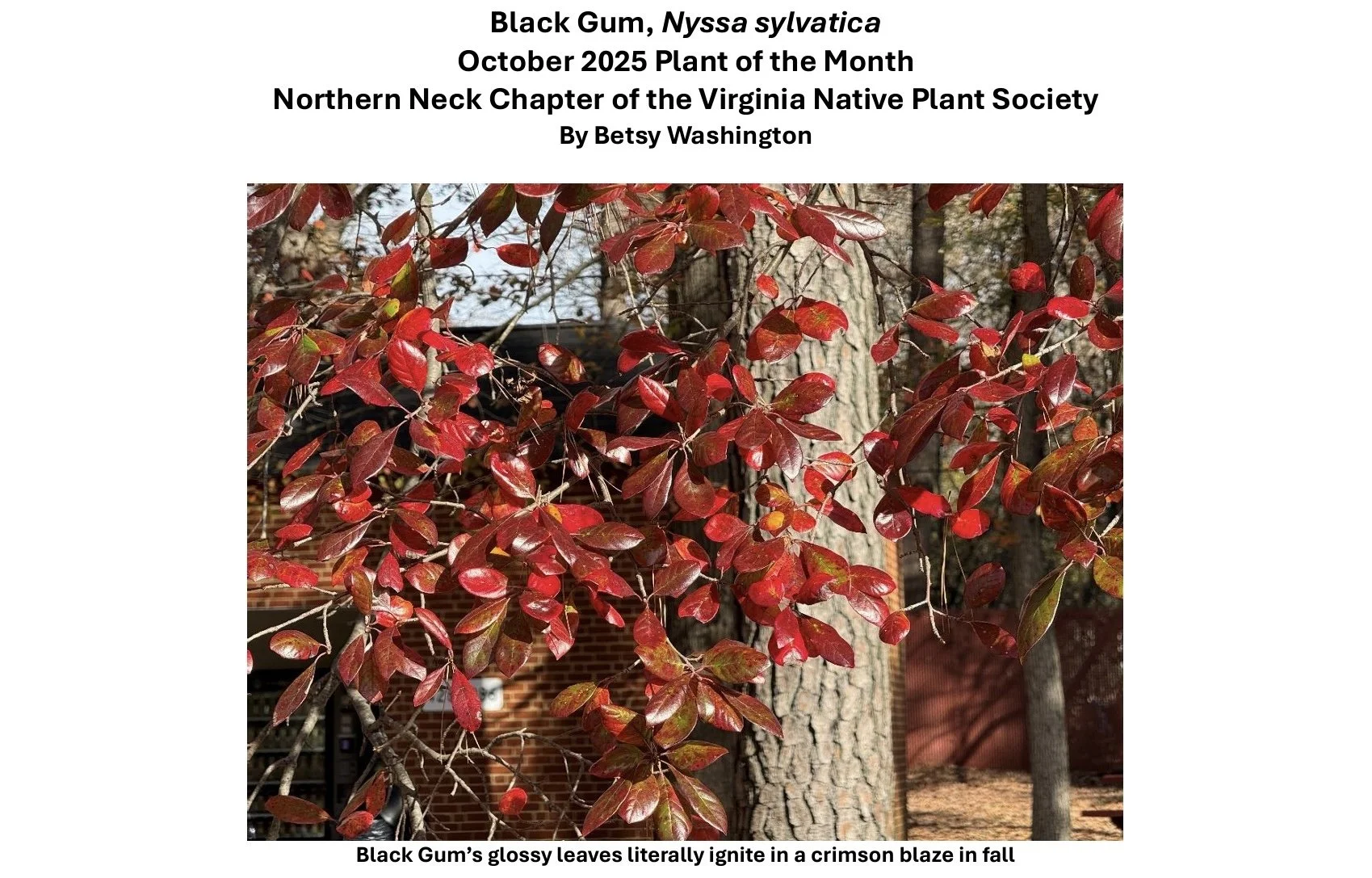Plant of the Month October 2025: Black Gum
One of the earliest and most reliable trees for fall color is our gorgeous Black Gum, Nyssa sylvatica. This native deciduous tree reliably ignites into fiery shades of scarlet and occasionally red, orange, even purple in the fall, often by late September. Not only does it color early but its spectacular color often lasts for up to a month or more, outlasting many other trees. Black Gums are often claimed to be the “most fiery of the brilliant trees”, including maples, dogwoods, and sassafras. This vivid fall color acts as a signal to migrating songbirds that nutritious fruit awaits them. But fall isn’t its only season of beauty. Black Gums have a distinctive silhouette with horizontal branches extending out at 90 degree angles from the straight trunk. The dark gray bark becomes deeply furrowed with age and distinctively blocky on old specimens and is often referred to as being like ‘alligator hide’. Trees that grow along lakes or rivers are especially beautiful as the lower horizontal branches often appear to droop or weep down towards the water. Black Gums are noticeable right now with their glossy, early-coloring scarlet leaves and fine horizontal branches that extend out over the roads. The leaves are 2 – 4-5” long, and obovate to elliptical in shape with a waxy appearance making them especially lustrous as if lacquered. This allows them to catch the light in both summer with their dark green color and in fall as they ignite in fiery hues. The dark green leaves and dark, nearly black bark give Black Gum its common name.
Black Gums are mostly dioecious with female and male flowers on separate trees, but some tree contain a few male and female flowers. Trees flower from late April – June with small clusters of tiny greenish-white flowers hidden by the expanding leaves. Humans often miss the floral show altogether, but a wide variety of bees and other pollinators gather to take full advantage of this rich source of nectar and pollen, including honeybees which make a prized honey from the nectar. Wildlife value continues in the fall, when small clusters of dark blue 2/3” long drupes (fleshy fruit) ripen, contrasting with the crimson foliage as it begins to take on scarlet tints. These fruits are especially high in lipids (fats) and are relished by many species of resident and migrating songbirds including thrushes, woodpeckers, cedar waxwings, eastern bluebirds and even wild turkeys and wood-ducks. Those that fall to the ground are eagerly eaten by a variety of mammals. Several moth species are known to use Black Gum as their host. The fruit is edible to us but quite sour, giving rise to another common name “Sour Gum”.
Black Gums are native to eastern North America ranging from Ontario south to Florida. In Virginia, Black Gums are common in every county in the Commonwealth and occur in a wide range of habitats from swamp margins, seepage swamps and floodplain forests to dry upland forests and rocky woodlands.
Black gums make an excellent landscape tree but are difficult to propagate and transplant due to the long, deep taproots that saplings develop. Black Gums are tolerant of a range of soils from wet to dry and even tolerate short-term flooding in spring and compacted urban soils. Black Tupelo is another common name from the indigenous peoples of the southeast – the Creek or Muscogee Indians. Tupelo being loosely translated from ‘ito’ meaning tree and opilwa’ meaning swamp.
Black Gum – Tupelo prefer full to part sun and moist, acidic soils but are adaptable and shade tolerant. Once established they are easy to grow and require little maintenance. They are best planted in spring as small trees from deep containers, especially those that allow root pruning to avoid harming the sensitive taproot. Deer do browse the foliage of young saplings and it is best to protect newly planted trees. Black Gums make a splendid long-lived shade tree and are among the longest lived non-clonal flowering trees, living up to 650 years. They make a spectacular shade or specimen tree and are perfect when used in moist soil along ponds, streams or low areas and even rain gardens. Black Gums are typically considered slow growing but can reach 30 – 50’ high and 20 – 30’ wide with a trunk diameter of more than 1’ under cultivation, however in the wild they can reach well into the canopy. The record Black Gum in 2000 was nearly 100’ in height with a trunk diameter of nearly 6’ and another massive tree in New Hampshire was documented at over 8’ in diameter! Trees are ever growing – height and width – but when hit by lightning, they most often grow very slowly upward but continue or increase growing in width. Not unlike many of us as we get older – we get shorter and wider.
Check out the roadsides and woodlands for the glossy scarlet leaves of Black Gums and be prepared to be dazzled. It’s a great time to plan your spring garden and add one or more Black Gums to your spring shopping list to bring year-round beauty and wildlife to your garden.


